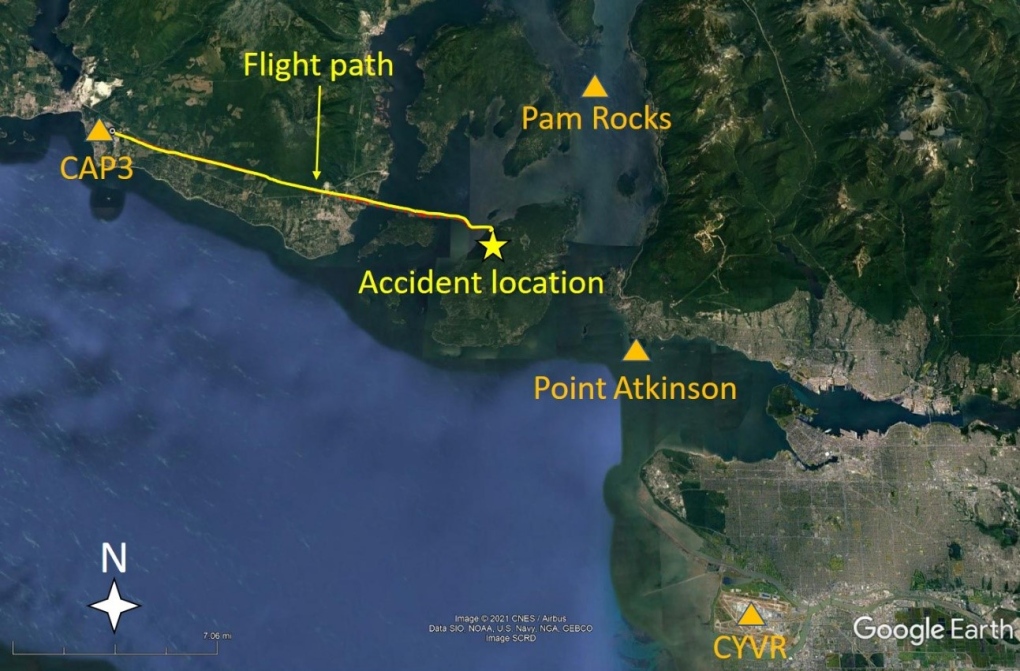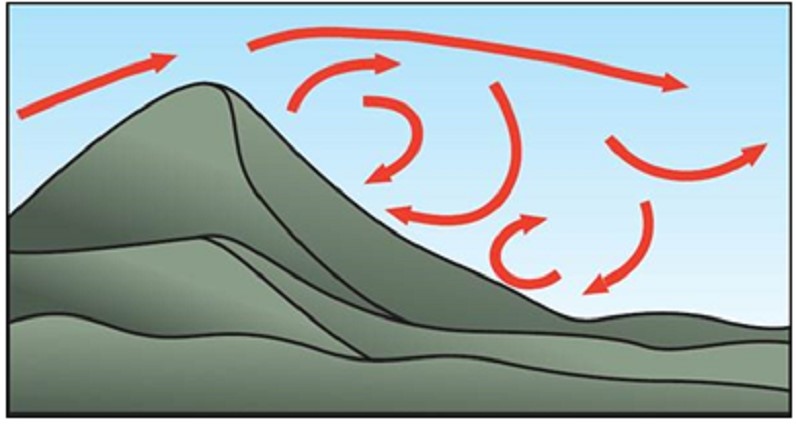Helicopter was out of control, rotating in moments before crash on B.C. island: report
 An image from the Transportation Safety Board shows a damaged helicopter following a crash on Bowen Island in March 2021.
An image from the Transportation Safety Board shows a damaged helicopter following a crash on Bowen Island in March 2021.
Pilots of a helicopter flying over British Columbia's coastline suddenly lost control, then an engine shut down before the aircraft started to spin and crashed into a rocky ridge, a just-released report on the 2021 crash details.
The pilots, who'd been flying from the Sunshine Coast to Metro Vancouver on March 5 of last year, crashed on Bowen Island due to "environmental conditions," according to the Transportation Safety Board of Canada.
They'd been headed from Sechelt to Cypress Provincial Park in a Bell 212 helicopter when the aircraft "entered wind shear and experienced a sudden loss of control," the TSB wrote in its report, released Thursday morning.
The crew was able to regain control at that time, but then one of its engines shut down and the flight controls became "very hard to manipulate," investigators said.
The pilots knew they needed to land, and chose Bowen Island as the site for their emergency landing.
They started to descend, and at that point, the helicopter "began a rapid rotation to the right." The pilots couldn't correct the rotation, and after several turns, the helicopter crashed into the ground.
It came to rest on a rocky ridge on the island, the TSB said.
Both pilots survived, but were seriously hurt. The chopper was "substantially damaged."
Following the crash, Airspan Helicopters Ltd. temporarily stopped operating and conducted a safety investigation. The company took several steps to avoid similar occurrences in the future, the TSB said.
 (Map from Transportation Safety Board)
(Map from Transportation Safety Board)
At the same time, the TSB was tasked to figure out what happened.
Its investigation found that the conditions that day, in that area, were "conducive to severe mechanical turbulence, lee waves and low-level wind shear."
These conditions were noted both on the planned flight path and near Bowen Island.
The pilots knew about the forecast, but still went ahead, hoping the weather would improve as it was forecast to do.
They wanted to complete the flight, and saw other aircraft operating in Sechelt, where they took off from, so they took off anyway.
According to the TSB, the helicopter entered an area of "severe turbulence," and that's why the pilots lost control. It resulted in "excessive flapping of the main rotor blades," causing those blades to hit the tail rotor driveshaft.
 (Graphic from Transportation Safety Board)
(Graphic from Transportation Safety Board)
"The helicopter’s extreme attitude during the initial loss of control likely caused the hydraulic system to malfunction, the number 2 engine to shut down in flight, and the number 1 engine to reduce fuel flow (resulting in less power), which subsequently reduced the main rotor speed," the TSB wrote in a news release.
Then, when the helicopter slowed down for the emergency landing, control was lost again and the helicopter crash landed.
CTVNews.ca Top Stories

What is flagpoling? A new ban on the practice is starting to take effect
Immigration measures announced as part of Canada's border response to president-elect Donald Trump's 25 per cent tariff threat are starting to be implemented, beginning with a ban on what's known as 'flagpoling.'
Hong Kong police issue arrest warrants and bounties for six activists including two Canadians
Hong Kong police on Tuesday announced a fresh round of arrest warrants for six activists based overseas, with bounties set at $1 million Hong Kong dollars for information leading to their arrests.
U.S. president-elect's son shares post on X of Donald Trump buying Canada on Amazon
U.S. president-elect Donald Trump and those in his corner continue to send out strong messages about Canada.
Read Trudeau's Christmas message
Prime Minister Justin Trudeau issued his Christmas message on Tuesday. Here is his message in full.
OPP and Ottawa firefighters help remove vehicle wedged into Highway 417 overpass
Ottawa firefighters and local Ontario Provincial Police officers were called to a bizarre scene Tuesday morning along Highway 417, where a driver managed to wedge his vehicle under an overpass.
Quebec fugitive gunned down leaving gym in Mexican resort town
RCMP are confirming that a fugitive, Mathieu Belanger, wanted by Quebec provincial police has died in Mexico, in what local media are calling a murder.
Indigenous family faced discrimination in North Bay, Ont., when they were kicked off transit bus
Ontario's Human Rights Tribunal has awarded members of an Indigenous family in North Bay $15,000 each after it ruled they were victims of discrimination.
Justin Baldoni's 'Man Enough' podcast co-host Liz Plank announces her departure
Justin Baldoni's 'Man Enough' podcast co-host Liz Plank announced she's stepping away from the show after actress Blake Lively accused the actor and director of sexual harassment and a smear campaign in a civil rights complaint last week.
Heavy travel day off to a rough start after American Airlines briefly grounds all flights
American Airlines briefly grounded flights nationwide Tuesday due to a technical problem just as the Christmas travel season kicked into overdrive and winter weather threatened more potential problems for those planning to fly or drive.
































